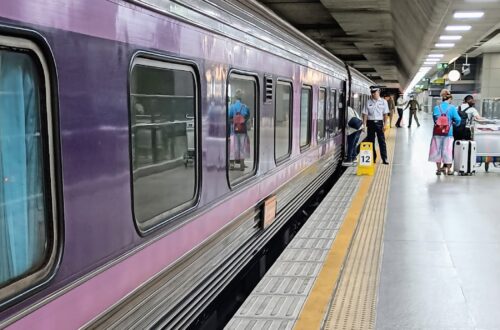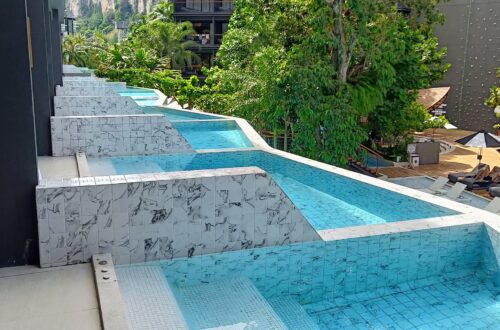
Sleeper Trains in Thailand (and what I wish I’d known)
Introduction: Why Take the Sleeper Train?
Taking the sleeper train in Thailand is a bit of a rite of passage for travellers in the country. Every year, millions of people use Thailand’s rail network, not just to get from A to B, but as part of the journey itself.
When I was planning my most recent trip to Thailand, my friend Heather strongly encouraged me to squeeze a sleeper train in there somewhere. She’d taken the Bangkok to Chiang Mai route on her travels, and described waking up to the jungle speeding by as one of the highlights of the trip.
Last summer, I’d planned to take two sleeper trains in Thailand – one to Chiang Mai as Heather had suggested, and one to Surat Thani in the south. I booked them both in advance, which I wrote about in a previous post, planned my trip around them… and then missed the first one.
The joys of Bangkok traffic.
You’ll be relieved to know I didn’t make the same mistake twice, and I’m so glad I had the chance to experience a sleeper train in Thailand after all.
Sleeper Train from Bangkok to Chiang Mai: The One That Got Away
My first planned stop after Bangkok was Chiang Mai. I’d booked the overnight train that was due to leave at 6:40pm, arriving into Chiang Mai the following morning at 7:15am. The train prices were really reasonable, about £23.
The day of the train, I checked out of the gorgeous Praya Palazzo. I wanted somewhere I could stash my bag for the day, and nap and shower before the train so I’d booked a day use hotel. I spent the day exploring a new neighbourhood of Bangkok, and ordered takeout to my day hotel to bring with me on the overnight train.
Finally, it was time to head out, so I hopped in a taxi to Krung Thep Aphiwat, Bangkok’s central train station. The map said it was a 40 minute drive, so I gave myself 90 minutes to get there.
As soon as we got out onto the main roads, the traffic was at an absolute standstill. As I watched the minutes tick by, I got more and more panicked. My phone battery was draining down as I kept refreshing the map.
Long story short, I got to the train station six minutes after my train had left – just in time to watch the departure board change. I knew there was another train at about 8pm, so I ran to the ticket office to see if there were any berths left. No luck.
I looked at the flights for that night or the next morning, but they were either too expensive or would only give me 24 hours in Chiang Mai.
Eventually, I decided Chiang Mai would have to wait for a future trip and set about planning my bonus two nights in Bangkok.
Bangkok to Surat Thani: Take Two
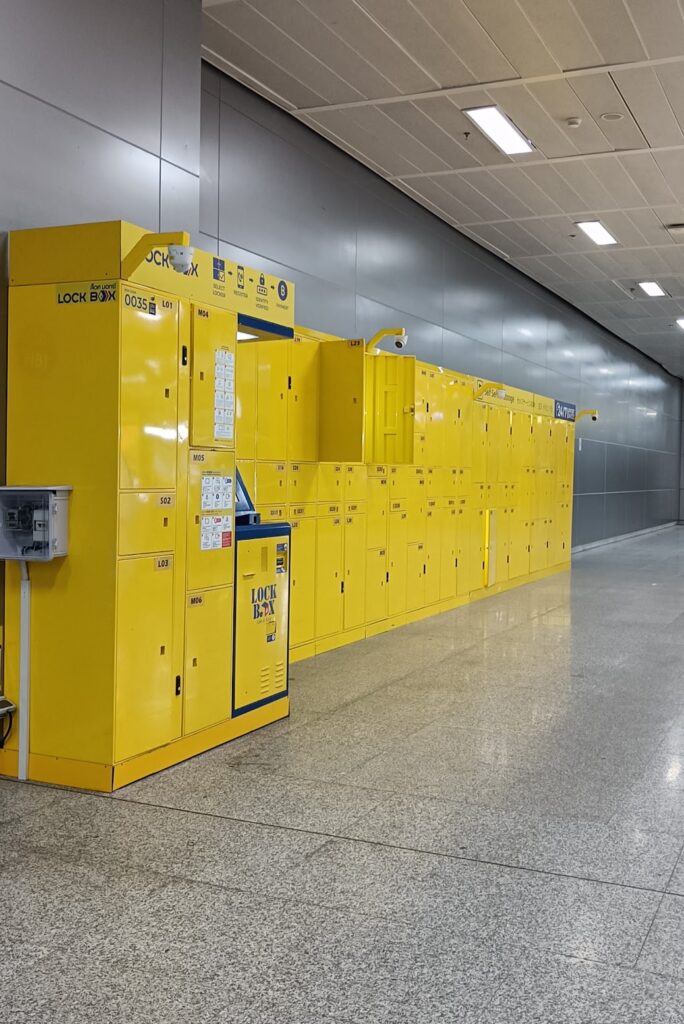
After my unexpected extra days in Bangkok, I wasn’t about to make the same mistake twice. This train was due to leave at 7:50pm and I was determined to be at the station by 6pm, even if it meant just hanging around gormlessly for two hours.
I went to the station after hotel checkout and stuffed my bag into one of the lockers in the station. It cost about £3 to store my bag for the day, and the machine I used only took cash – so make sure you have some spare.
Near Krung Thep station is Chatuchak Weekend Market. Since I was travelling on a Sunday, I decided to spend the day browsing the market, knowing I was only a five minute drive from the station.
The market is enormous with so much to explore, so it deserves a future post of its own.
I also hopped on the BTS metro to pay a quick visit to V Street, picking up some takeaway for train dinner.
As I’d promised myself, I got to the station at exactly 6pm. Inside the station, there is a small food court with various vendors and plenty of seating. There are also benches dotted around the station, as well as power points to charge your devices before your journey.
Real talk, I’d completely overcorrected in how much time I needed before the train. While the station is clean and has everything you need, it’s not a comfortable place to hang out. The queue for my train didn’t start forming and moving until about 15 minutes before departure. Because everyone has a berth or seat booked, it’s not a big rush to get onboard and claim space.

Eventually, I was walking onto the platform, a long purple train stretching out in front of me.
After all the planning (and one missed train), it was finally time to see what a night on a sleeper train in Thailand was like.
Onboard Experience
Cabin Setup
I’d booked a second class ticket, which is generally the most popular for travellers. It’s a great middle ground: affordable, comfortable and with a degree of privacy. The entire carriage serves as a dormitory, with a privacy curtain around each bed.
During the day, the lower berth is set up as two seats facing each other. The seats were laid out like this when we first boarded. My berthmate, a young monk, and I nodded at each other and sat down as we started moving.
Not long after we departed, the train attendants came around to transform the seating into night mode: bunk style beds. The attendants are incredibly fast – each berth takes them less than a minute to set up.
Once the bed is made up, a curtain pulls across the entire berth for privacy, giving you your own little pod for the night. The lower bunk is wider than the upper one and has a window, which makes it feel less cramped and gives you a view when you wake up. It’s definitely worth the slight extra cost over the upper berth, and my train ticket cost me around £17.
There’s a space under the bed for bags and shoes, although I kept my belongings with me while I slept. I’m only 5’2”, so I don’t need a ton of leg room!
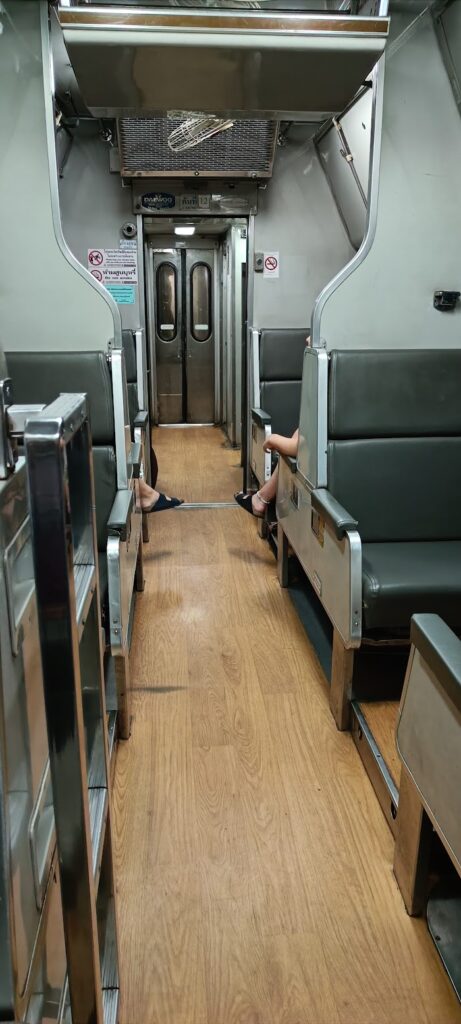
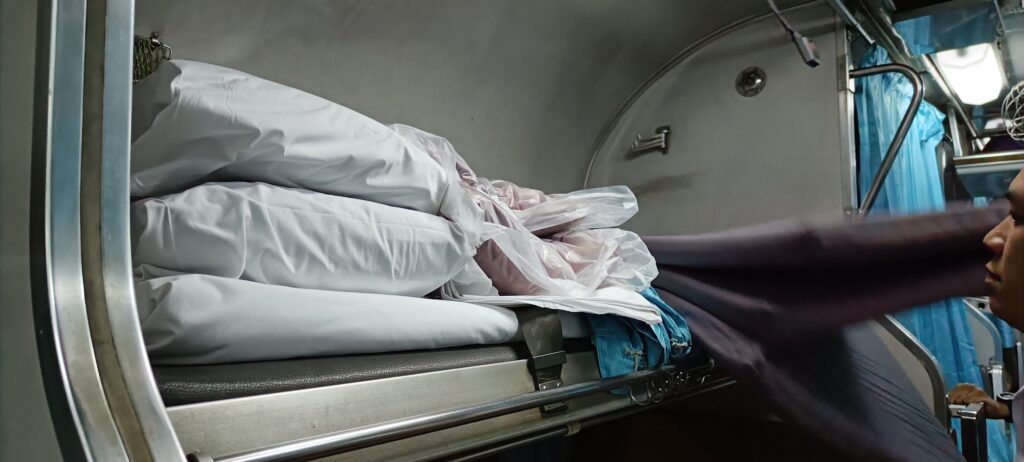
Comfort & Cleanliness

I’d chosen to travel on one of the trains that have air conditioning. Some sleeper trains in Thailand are only cooled by fans, so do keep an eye out for the fan or AC symbol when you’re booking!
I had no issues with heat all night, and the temperature was perfect.
The beds as I’ve mentioned are expertly made up by attendants, who lay down a clean sheet and small pillow. They also provide blankets, which came wrapped in plastic, as if to assure us of their freshness.
The pillows are quite thin, so you may find that a folded up scarf or jumper underneath helps. I’ve got a small inflatable travel pillow that I bring away with me, and I’m always glad of it in situations like this.
Toilets & Washrooms
Each train carriage has two toilets – one western style, and one eastern style squat toilet. As you’d expect, these get dirtier as the journey goes on but are overall fine. The ones in my carriage ran out of toilet paper as we got closer to Surat Thani, so I’d recommend having some in your bag just in case!
There were two side by side sinks outside of the toilets, allowing space for people to brush their teeth before bed.
Food & Snacks
Before I boarded, I picked up dinner from V Street and I’m glad I did. While there is food available on the train, I wasn’t certain it’d be vegan friendly. There’s a dining car on most sleeper trains, and attendants also come through the carriages offering set meals (usually rice with some kind of curry or stir fry), drinks, and snacks.
Because I’d packed my own meal, I can’t vouch for the food offerings on the train. I would recommend coming well prepared with bottled water and some snacks.
Beer or other alcohol isn’t sold or officially permitted on Thai trains. Some people do discreetly have a drink within their own berths, but there could be a fine if you get caught, so do so at your own risk.
Noise & Sleep
I’m a truly terrible sleeper, and yet I always sleep like a baby on trains. There’s something about the rocking motion that just sends me off.
In the carriage, the main overhead lights stay on overnight. While the privacy curtains block out some of the light, it’s worth bringing a sleep mask if you sleep better in darkness.
As for noise, the other passengers settled into their berths fairly early and noise was minimal. Inevitably, you may hear some people chatting or making their way to the bathrooms, so earplugs can’t hurt.
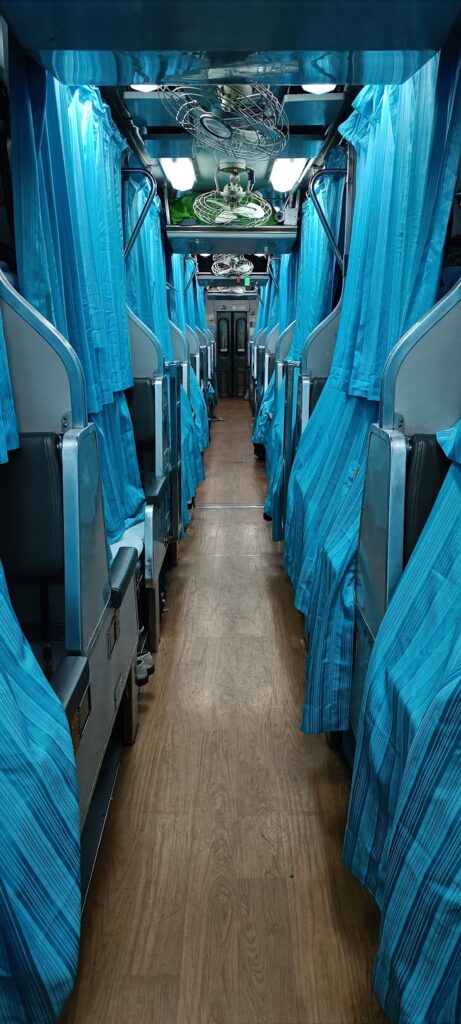
Wi-Fi, Charging & Connectivity
There were no charging ports in my berth, nor any wifi on the train. I had bought an eSim before I left the UK, so I had pretty good connectivity throughout the journey.
I have heard that some berths and cabins have sockets or charging ports, but it’s always wise to have a fully charged power bank just in case!
Arrival in Surat Thani
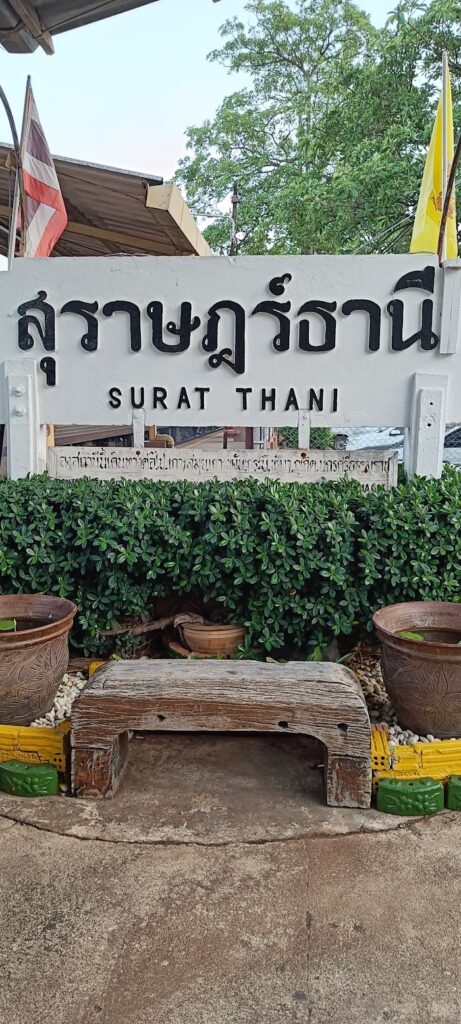
We pulled into Surat Thani just after 6am. I’d set my alarm for 5:30am, so I was awake to watch the sun rise in the hazy sky as we sped by the Thai countryside. Sleeper trains in Thailand might be your accommodation for the night, but they’re not hotels – usually you’re expected to disembark as soon as it arrives in the station.
Surat Thani station itself is pretty small and straightforward. As soon as you step off the train, you’ll see signs for onward trains, taxis and buses.
Surat Thani tends to be a gateway to Southern Thailand, and a lot of travellers carry onward towards Koh Samui, Koh Phangan, or Khao Sok – where I was headed.
Despite the early hour, there was a great buzz of excitement from other travellers heading on for their next adventure, and I felt surprisingly well rested – and really glad I got to have the sleeper train experience after all!
Tips for First Timers
Quick Tips for Thai Sleeper Trains
- Book in advance, I’ve got some more tips here
- Aim to arrive early to the station, but not too early – about an hour should do you. And if you’re travelling to Bangkok station at rush hour, beware.
- Lower berth = more space + a window
- Bring snacks, water, and your own dinner if you have dietary restrictions. I’ve got a small, foldable insulated bag that’s come in handy for keeping food fresh.
- 🌡 AC vs. fan trains: double check before booking
- Pack toilet paper and hand sanitiser
- No guaranteed outlets, carry a power bank
- Sleep mask and earplugs = a better night’s sleep





